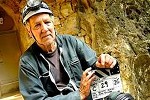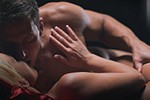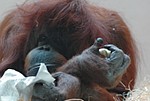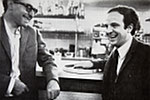 Shadows off the beaten path
Shadows off the beaten pathTHE LOVERS' GUIDE: IGNITING DESIRE | NENETTE | TWO IN THE WAVE
< < D O C S > >
last update 10.Feb.11
See also: SHADOWS FILM FESTIVAL
 R E V I E W B Y R I C H C L I N E
R E V I E W B Y R I C H C L I N E MUST
MUST  SEE
SEE
prd Erik Nelson
with Werner Herzog, Dominique Baffier, Jean Clottes, Maurice Maurin, Wulf Hein, Jean-Michel Geneste, Carole Fritz, Gilles Tosello, Michel Philippe, Julien Monney, Nicholas Conard, Maria Malina
 release UK 25.Mar.11,
release UK 25.Mar.11,US 29.Apr.11
10/France 1h35
TORONTO FILM FEST
 What could have been a revealing but relatively dry documentary is given the usual twist by genius filmmaker Herzog, who turns a glimpse of rarely seen prehistoric cave paintings into a bravura 3D exploration of human history.
What could have been a revealing but relatively dry documentary is given the usual twist by genius filmmaker Herzog, who turns a glimpse of rarely seen prehistoric cave paintings into a bravura 3D exploration of human history.
Discovered in 1994, the Chauvet caves in southern France were sealed by a landslide 20,000 years ago and contain the oldest paintings ever seen. More than 30,000 years old, they depict the wildlife of prehistoric Europe - horses, rhinos, lions, bison - with a remarkable sense of movement. And the caves themselves are pristinely beautiful, with stalactites, stalagmites and a remarkable collection of animal bones. But what was the world like back then, when Europe was under ice and our ancestors lived alongside Neanderthals?
Herzog takes us into the cave with his camera crew, crowded onto narrow walkways and forbidden from touching anything. The 3D high-def images beautifully catch the shapes of the cave walls, on which we see what are essentially 3D paintings. And by playfully moving his light-sources, Herzog creates the dramatic illusion that the images are in motion. We feel like we're watching living artwork, which in a way is what it is. And we also vividly sense the link between ourselves and our pre-history.
In addition, Herzog and his crew travel to other sites to talk to experts and explore the use of paintings and music during the period, with revealing results (expert Hein plays the American national anthem on a prehistoric flute). And through it all, Herzog's deadpan observations continually surprise us with their askance insight. We have no way of even guessing what life was like that long ago, so are we looking back at our ancestors like, say, a radioactive albino alligator looks at us today?
Watching this film is perhaps the closest thing to time travel that we can ever experience. And through Herzog's exclusive access, it's also the only chance we'll ever get to soak up the atmosphere inside Chauvet. With Herzog behind the camera we experience this place and the resonance it conveys with a remarkable clarity. And his deadpan observations are hugely entertaining. In other words, watching this film is probably even more thrilling than clambering into the cave in person.
26.Jan.11
 R E V I E W B Y R I C H C L I N E
R E V I E W B Y R I C H C L I N E
scr Emily Dubberley, James Buffalino
prd William Campbell, Robert Page
narr Gemma Bissix, Jeremy Edwards
with Cathy, Nick, Jasmine, Otto, Paula, Christian, Lana, Sebastian, Bea, James
 release UK 7.Feb.11 dvd
release UK 7.Feb.11 dvd11/UK 1h03
 Released in one UK cinema then straight to DVD, this 3D soft-porn oddity is completely inexplicable, mainly because the only people who could find it either sexy or informative are pre-teens. Or maybe the extremely repressed.
Released in one UK cinema then straight to DVD, this 3D soft-porn oddity is completely inexplicable, mainly because the only people who could find it either sexy or informative are pre-teens. Or maybe the extremely repressed.
With almost comically pointless his-and-her narration by Edwards and Bissix, the film takes us through a series of chapters that are illustrated by plucked and waxed models in various states of undress. The first problem is that the chapter titles are extremely random: "Caress" is followed by "Touch". But the bigger issue is that the models look thoroughly bored by all of this. Besides being groomed to within an inch of their lives, the soft lighting and slow-motion photography eliminate any sense of authenticity. So the lack of actual passion actually becomes silly.
And it's even funnier to see how the filmmakers are terrified of using the 3D in ways that would so obviously spice things up. With one very brief exception, they miss every opportunity for gratuitous in-your-face shots, which leaves us wondering why they bothered at all. Because anyone who finds this film interesting or arousing is utterly disconnected from reality. The activities on screen are merely a glowingly idealistic portrayal of artificial sex.
It also doesn't help that the narration sounds like it was written after surfing for information on Wikipedia. We hear virtually nothing remotely informative or suggestive; most of the commentary consists of statements as profound as, "If you touch your partner, they'll like it." Sure, this might help a couple whose intimacy has dried up, but the section on spicing up your sex life is laughably simplistic, and anything actually adventurous is carefully avoided. As is any hint at non-straight sexuality.
In other words, even a 10-year-old knows more than is conveyed in this film. And the imagery is so over-staged and choreographed that it's impossible to take seriously, although it could cause nervous giggles to anyone who thinks sex is something naughty or forbidden. But as the models arch their backs and lick their teeth in feigned ecstasy, most audience members will just wish that they were watching actual porn instead. Because even with a corny storyline and equally bad performances, at least it's sexier than this.
7.Nov.10
 R E V I E W B Y R I C H C L I N E
R E V I E W B Y R I C H C L I N E
prd Serge Lalou
 release Fr 31.Mar.10,
release Fr 31.Mar.10, UK 4.Feb.11
10/Fr 1h09
BERLIN FILM FEST

 This engaging documentary is deceptively simplistic, purely using footage of orangutans at France's oldest zoo accompanied by ambient sounds of their keepers and the people watching them. But what it says about nature and humanity is intriguingly thoughtful.
This engaging documentary is deceptively simplistic, purely using footage of orangutans at France's oldest zoo accompanied by ambient sounds of their keepers and the people watching them. But what it says about nature and humanity is intriguingly thoughtful.
The star orangutan is Nenette, the beloved 40-year-old grand dame at the Jardin des Plantes in Paris. From the voices off-screen we learn that she arrived from Borneo in 1972 and has outlived her three mates to raise her four offspring. Older zookeepers remember her as a terror, causing all manor of mischief. But now she's mellow and observant, perhaps bored by the lack of adventure in her life and the years of pampering. She lives with her son and prefers to pour tea into her yoghurt, into which her current keepers insert a contraceptive.
Without ever stating the question, director Philibert is asking us if this is any way for an orangutan to live. Yes, she has had a very comfortable life and has lived far longer than orangutans survive in the wild, but is she essentially a kidnapping victim, unable to make any decisions for herself? Has she had her essence tamed right out of her? This isn't through any mistreatment - her keepers adore her - but because her lifestyle is so blatantly unnatural. So is she really an orangutan at all any more?
Of course members of the general public love her as well, with some people visiting her regularly "as if she were a relative in prison". We hear their voices too, including small children asking questions that are far more telling than they sound, as they probe the very nature of zoos and the complex relationship between humans and animals. But we never see any of these people on screen: the camera only has eyes for Nenette and her children.
The surprise is that, even with this basic structure and 70-minute running time, Philibert not only tells us rather a lot about orangutans, their history and their interaction with humans, but he also gives us an engaging glimpse into the way we interact with the animal world. Like his other observational classic, 2002's Etre et Avoir (To Be and to Have), he lets his subjects speak for themselves. Even if, as in this case, they can't use words to tell us how they feel.
25.Jun.10 eiff
 R E V I E W B Y R I C H C L I N E
R E V I E W B Y R I C H C L I N E Deux de la Vague
Deux de la Vague
scr Antoine de Barcque
with Isild Le Besco, François Truffaut, Jean-Luc Godard, Jean-Pierre Leaud Jean-Paul Belmondo, Jean Seberg, Claude Chabrol, Fritz Lang, Jeanne Moreau, Charles Aznavour, Anouk Aimee, Anna Karina

release US 19.May.10,
UK 11.Feb.11
09/France 1h31
BERLIN FILM FEST

 This fascinating documentary explores the historic friendship between François Truffaut and Jean-Luc Godard as they rode the French New Wave. In other words, it's pretty much only going to appeal to die-hard film fans.
This fascinating documentary explores the historic friendship between François Truffaut and Jean-Luc Godard as they rode the French New Wave. In other words, it's pretty much only going to appeal to die-hard film fans.
After very different childhoods, Truffaut and Godard met as teens and became close friends as journalists for Cahiers du Cinema. They made several shorts, but it was Truffaut who triumphed first with his boldly against-the-flow 1959 classic The 400 Blows, which gave him the clout to help Godard make Breathless in 1960. Between them they also made young actor Leaud a star. So when their friendship imploded in the late 60s, he was like a child caught in a nasty divorce.
By framing this iconic relationship through Leaud's eyes, filmmaker Laurent finds an emotional element in the story that's otherwise lacking. Especially since a good chunk of the film consists of shots of magazine pages and still photos with a narrator telling us how marvellously talented both filmmakers were. Yes, they made some of the most important films of the period, but stating the obvious undermines the doc.
Much more important are the film clips, which are never identified but take us on a terrific journey through the Nouvelle Vague, constantly returning to Leaud's young, unforgettable face in The 400 Blows. It's fascinating to see how Truffaut's rough childhood and Godard's life of privilege are reflected not only in their films but in how they react to the tumultuous changes in French society in the late 60s. Truffaut takes a more mainstream artistic turn, while Godard resolutely holds on to his anarchic-artiste style.
Behind-the-scenes footage from film sets, newsreel clips and home movies add terrific texture. And really, these and the classic film scenes tell us everything we need to know without all the narration. Because by the end it feels like we're watching someone's doctoral thesis rather than a documentary for a wide audience. If you're unfamiliar with film cinema, the names of influential directors and the work of these two geniuses, this might feel like a bit of a blur. But as a document about an important relationship, it's a priceless piece of cinema history.
12.Jul.10


See also: SHADOWS FILM FESTIVAL
© 2011 by Rich Cline, Shadows
on the Wall
